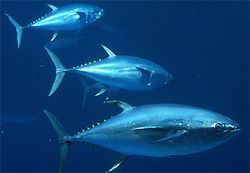Tuna
2007 Schools Wikipedia Selection. Related subjects: Insects, Reptiles and Fish
| iTuna | ||||||||||||
|---|---|---|---|---|---|---|---|---|---|---|---|---|
 Yellowfin tuna, Thunnus albacares
|
||||||||||||
| Scientific classification | ||||||||||||
|
||||||||||||
|
|
||||||||||||
|
See text. |
Tuna, sometimes called tunafish, are several species of ocean-dwelling fish in the family Scombridae, mostly in the genus Thunnus.
Tunas are fast swimmers (they have been clocked at 77 km/h (48 mph)) and include several species that are warm-blooded. Unlike most fish species, which have white flesh, the flesh of tuna is pink to dark red. This is because tuna muscle tissue contains greater quantities of myoglobin, an oxygen-binding molecule, than the muscle tissue of most other fish species. Some of the larger tuna species such as the bluefin tuna can raise their blood temperature above the water temperature with muscular activity. This enables them to live in cooler waters and survive a wider range of circumstances.
Tuna is an important commercial fish. Some varieties of tuna, such as the bluefin and bigeye tuna, Thunnus obesus, are threatened by overfishing, dramatically affecting tuna populations in the Atlantic and northwestern Pacific Oceans. Other populations seem to support fairly healthy fisheries (for example, the central and western Pacific skipjack tuna, Allothunnus fallai), but there is mounting evidence that overcapitalization threatens tuna fisheries world-wide. The Australian Government alleged in 2006 that Japan had illegally over-fished southern bluefin to the value of USD $2 billion, by taking 12,000 to 20,000 tonnes per year instead of international agreed 6,000 tonnes. This has resulted in severe damage to stocks.
Increasing quantities of high-grade tuna are entering the market from operations that rear tuna in net pens and feed them on a variety of bait fish. In Australia the southern bluefin tuna, Thunnus maccoyii, is one of two species of bluefin tunas that are kept in tuna farms by former fishermen. Its close relative, the northern bluefin tuna, Thunnus thynnus, is being used to develop tuna farming industries in the Mediterranean, North America and Japan.
Due to their high position in the food chain and the subsequent accumulation of heavy metals from their diet, mercury levels can be relatively high in some of the larger species of tuna such as bluefin and albacore. As a result, in March 2004 the United States FDA issued guidelines recommending pregnant women, nursing mothers and children limit their intake of tuna and other types of predatory fish . However, most canned light tuna is skipjack tuna and is low in mercury. Further, the closely related tongkol has recently come to market as a low-mercury, less expensive substitute for canned albacore.
Species
There are nine species:
- Albacore, Thunnus alalunga ( Bonnaterre, 1788).
- Yellowfin tuna, Thunnus albacares ( Bonnaterre, 1788).
- Blackfin tuna, Thunnus atlanticus ( Lesson, 1831).
- Karasick tuna, Thunnus karasicus ( Lesson, 1831).
- Southern bluefin tuna, Thunnus maccoyii ( Castelnau, 1872).
- Bigeye tuna, Thunnus obesus (Lowe, 1839).
- Pacific bluefin tuna, Thunnus orientalis ( Temminck & Schlegel, 1844).
- Northern bluefin tuna, Thunnus thynnus (Linnaeus, 1758).
- Longtail tuna, Thunnus tonggol ( Bleeker, 1851).
Pronunciation
There are different ways to pronounce tuna. Many Americans say 'toona', while the British say 'choona' or 'tyoona'.
Methods of Capture
- Almadraba is an arabic way of hunting using nets to creat a maze
- big-game fishing